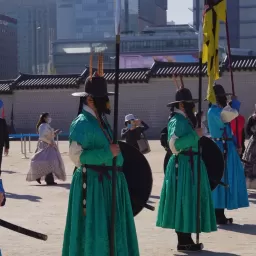Music And Dance
Korea’s musical and dance heritage is multifaceted, encompassing traditional forms like Gugak, Pansori, and Buchaechum
 Bonus: Korean Culture:
Korean culture is a blend of tradition and modernity, preserving its heritage while embracing contemporary influences. Let’s learn more about it.
Bonus: Korean Culture:
Korean culture is a blend of tradition and modernity, preserving its heritage while embracing contemporary influences. Let’s learn more about it.
Traditional Korean music, known as Gugak, has a rich history that dates back centuries. It encompasses various genres, including instrumental music, vocal music, and dance. Pansori, a form of traditional Korean vocal music, is a unique and expressive art form that involves a solo singer accompanied by a drummer. Pansori performances often tell epic stories and require a high level of skill and emotional expression from the vocalist.
In traditional Korean dance, Buchaechum, or the fan dance, is a prominent and elegant form. Dancers wear vibrant hanbok (traditional Korean clothing) and use large, colorful fans to create intricate and graceful movements. The dance often symbolizes natural elements such as flowers, butterflies, and waves.
Gugak and traditional dances are important cultural elements that showcase Korea’s artistic heritage and are often performed during ceremonies, celebrations, and other cultural events.
On the contemporary side, South Korea has made a significant impact on the global music scene through K-Pop (Korean Pop). K-Pop is characterized by its catchy melodies, impressive choreography, and visually appealing music videos. Groups and solo artists like BTS, BLACKPINK, EXO, and many others have gained immense popularity worldwide.
K-Pop’s success is not only attributed to its musical aspects but also to the carefully choreographed dance routines that accompany the songs. K-Pop idols are known for their synchronized and dynamic performances, and dance has become a crucial element in the genre’s identity. Choreographers play a vital role in creating visually stunning routines that contribute to the overall entertainment value of K-Pop music.
The global popularity of K-Pop has led to a phenomenon known as the "Korean Wave" or "Hallyu," where Korean entertainment, including music and television dramas, has gained a massive international fan base. K-Pop’s influence extends beyond music, impacting fashion, beauty, and youth culture around the world.
In summary, Korea’s musical and dance heritage is multifaceted, encompassing traditional forms like Gugak, Pansori, and Buchaechum, as well as the contemporary global phenomenon of K-Pop, which has become a major cultural export, shaping perceptions of Korean culture on a global scale.